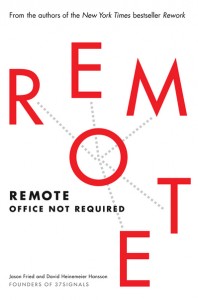
Previously we reviewed their earlier book Rework. This one is equally brilliant, easy to read and super useful.
It’s an Important Trend
For the past 500 years workers have been employed and paid based on showing up at the workplace and doing their work. It started in the factory because that’s where the machines were and then we moved into offices.
This book is about an important historical break in that connection. And, as with most big trends these days it’s driven by the internet and digital technology. With your laptop, smartphone and a wireless connection most of us can now work effectively anywhere in the world.
The telecommuter has arrived. As they neatly say in the book remote work has passed the first two stages of Gandhi’s model for change:
First they ignore you, then they laugh at you, then they fight you, then you win.
Common Complaints
We’re currently in the fight stage. And this book firmly addresses the fight and the concerns and common complaints for why remote work won’t work. Here’s a sample:
- Great work only happens when people are in the same room
- If I can’t see you then how do I know you’re working?
- The home has more distractions than the office
- The office is the most secure location
- Who is going to answer the phone if everyone is working their own hours in remote locations?
- Big business is not doing it
- Those working in the office will simply become jealous
Sell Your Office Space
[Tweet “Great guidebook for working smarter and remotely: #BookReview: #Remote by Jason Fried and David Heinemeier Hansson”]
The big deal clincher for me is the quote from IBM. They’ve been promoting telework within their organisation since way back in 1995. Since then, 40% of their workforce or a mere 154,000 people telework on a regular basis. This has allowed IBM to reduce their office space requirements by a massive 58 million square feet saving several billion dollars. Yes, that’s right, several B for billion dollars.
This has serious implications for urban design.
Plus, there are a number of studies that suggest workers get more done working remotely. And, they’re more likely to work too much than too little.
Lessons from Experience
One of the compelling aspects of this book is that it’s written from their own experience of building their highly successful software business with remote workers. And, the simple starting point is that Jason is based in Chicago and David in Copenhagen. Their staff are scattered throughout Chicago, the US and the world.
Practical Suggestions
The book is filled with practical suggestions on:
- How to collaborate remotely
- Overcoming the natural challenges
- How to maintain security
- Hiring the best people and keeping them
- How to manage remote workers
- How to manage yourself as a remote worker
Easy to Read
Best of all, it’s a simple easy read in everyday language.
It’s a must read for any office manager who wants to save some money, attract and keep better people and improve productivity. This is the new way to work!
More about Remote the book from the authors at 37 Signals.



